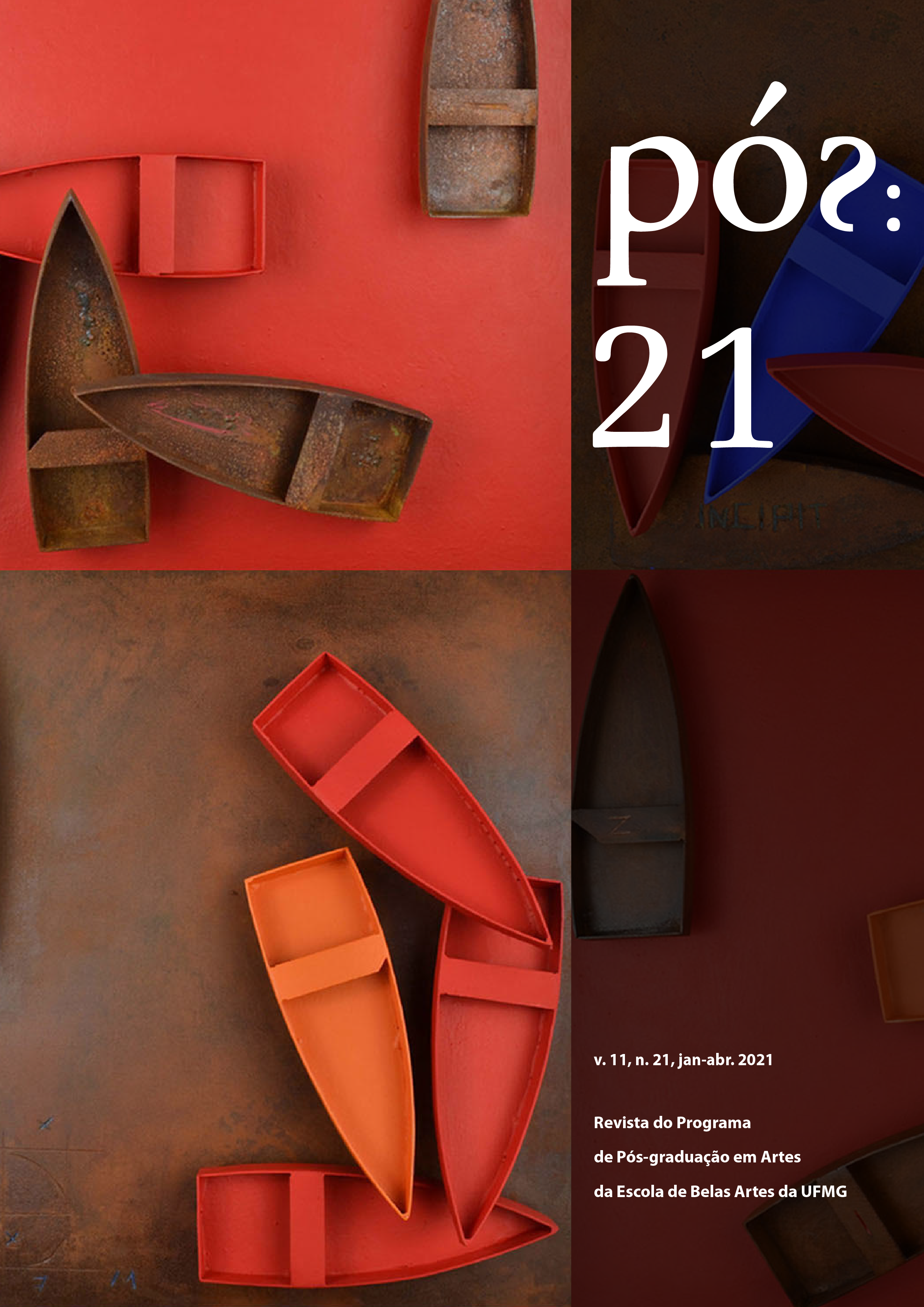Geometry in Gilvan Samico’s engravings
between technique and narrative, the rationalization of the mythic space
DOI:
https://doi.org/10.35699/2237-5864.2021.20564Keywords:
Gilvan Samico., Woodcut., Engraving., History of images., Art of memory.Abstract
The present text aims to explain how the use of geometrical shapes, that occurred in the works of Gilvan Samico, has interfered with the construction of the images’ space, seeking to understand some of the meanings that the woodcuts can take from that transformation onwards. To that end, the images are comparatively analyzed, considering their relationship with words and memory, their cultural traits and their temporality. Conceiving the power of the image as an object that awakens stories and memories, what is inherent to the engravings is placed in parallel with the construction of a rational mathematical thought in art. Samico’s work is marked by the survival of memory images, that is transversal in techniques, themes and form.
References
AMARAL, Aracy. Arte para que? A preocupação social na arte brasileira 1930 – 1970. São Paulo:
Livraria Nobel, 1984.
BARROS, Leandro Gomes de. A história de Juvenal e o dragão. Recife: [s.n., 19-? ]. 20 p. Disponível em <http://docvirt.com/docreader.net/docreader.aspx?bib=RuiCordel&pasta=&pesq=LC6043>. Acesso em: 25 mar. 2020.
BELTING, Hans. Antropologia da Imagem. Para uma ciência da imagem. Tradução de Artur Morão. Lisboa: KKYM, 2014.
BRITO, Ronaldo. Samico: do desenho à gravura. In: ______. Samico: do desenho à gravura. São
Paulo: Pinacoteca do Estado, 2004. p. 11-13
COUTO, Maria de Fátima Morethy. Por uma vanguarda nacional. A crítica brasileira em busca de uma identidade artística (1940-1960). Campinas: Editora da Unicamp, 2004.
DIDI-HUBERMAN, Georges. A imagem sobrevivente: história da arte e tempo dos fantasmas
segundo Aby Warburg. Rio de Janeiro: Contraponto, 2013.
DELARUE, Paul. Le conte de l'homme aux trois chiens. In: DIDI-HUBERMAN, Georges. Saint Georges et le dragon. Versions d'une légende. Paris: Adam Biro, 1994. ISBN 2-87660-139-7. Publicado originalmente em DELARUE, Paul. Le conte populaire français. Catalogue raisonné des versions de France et des pays de langue française, Paris, Érasme, 1957, I. p. 145.
ELIADE, Mircea. O sagrado e o profano. tradução Rogério Fernandes. São Paulo: Martins Fontes, 1992.
FONSECA, F. Entrevista com Gilvan Samico. ouvirOUver, Uberlândia, 15(2), p. 620-633. 2020.
Disponível em <https://doi.org/10.14393/OUV-v15n2a2019-50281>. Acesso em 10 mai. 2020.
MORAIS, Frederico. Encantamento. In:______. Samico: 40 anos de gravura. 1. ed. reimpr. – Rio de Janeiro: Centro Cultural Banco do Brasil; Recife: Museu de Arte Moderna Aloísio Magalhães, 1998. p.7-11.
PANOFSKY, Erwin. A perspectiva como forma simbólica. In: ARGAN, Giulio Carlo. História da arte italiana. São Paulo: Cosac&Naify, 2003. v. 2.
SAMAIN, Etienne. As imagens não são bolas de sinuca. Como pensam as imagens. In: ______. Como pensam as imagens. Campinas: Editora da Unicamp, 2012. p. 21-36.
SAMICO, Gilvan. Depoimento. In: BRITO R. C., Samico: do desenho à gravura. São Paulo: Pinacoteca do Estado, 2004. p. 23-54.
VALDEON, Julio. León y Castilla. Historia de España. Feudalismo y consolidación de los pueblos
hispánicos (siglos XI - XV). 3ª ed. Barcelona: Editorial Labor S.A., 1983
YATES, Frances Amelia. A arte da memória. Tradução de Flavia Bancher. Campinas: Editora da
Unicamp, 2007.
ZUMTHOR, Paul. La lettre et la voix de la “littérature” médiévale. Paris: Editions Du Seuil, 1987.
Downloads
Published
How to Cite
Issue
Section
License
Copyright (c) 2021 Fabio Fonseca

This work is licensed under a Creative Commons Attribution-NonCommercial 4.0 International License.
Authors who publish in this journal agree to the following terms:
- Authors retain copyright and grant the journal the right of first publication, with the work simultaneously licensed under the a Creative Commons Attribution-NonCommercial 4.0 International License that permits sharing of the work with acknowledgement of authorship and initial publication in this journal;
- Authors are permitted to enter into additional contracts separately, for non-exclusive distribution of the version of the work published in this journal (e.g., the Creative Commons Attribution License).
- Authors are permitted and encouraged to publish and distribute their work online (e.g., in institutional repositories or on their home page) at any point before or during the editorial process, as this may generate productive changes as well as increase the impact and citation of the published work.
- It is the responsibility of the authors to obtain written permission to use in their articles materials protected by copyright law. Revista PÓS is not responsible for copyright breaches made by its contributors.












